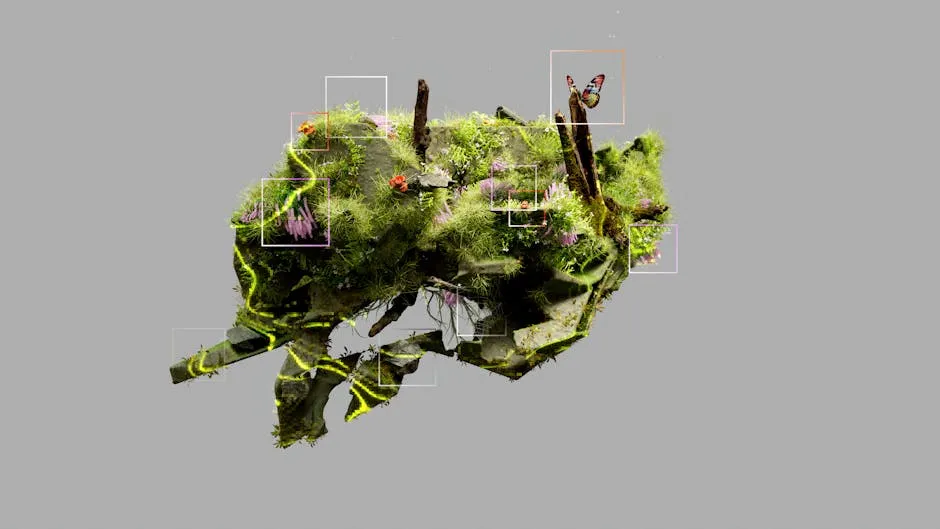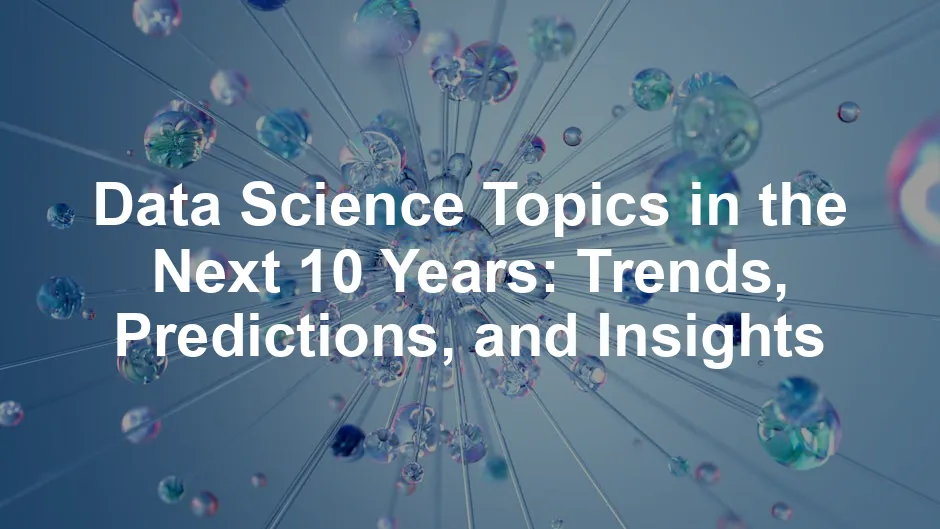Introduction
Data science is evolving at an incredible pace. Emerging trends and technologies are reshaping how we approach data. In this article, we will explore key data science topics expected to gain prominence in the next decade.

For a deeper understanding of data science fundamentals, check out this article on statistical inference for estimation in data science.
Summary and Overview
The data science landscape has changed dramatically over the years. Initially, data science focused on basic statistical analysis. Now, it integrates advanced technologies like machine learning and artificial intelligence. The exponential growth of data generation has transformed various sectors, creating a surge in demand for data professionals.
By 2025, the global data sphere is expected to grow to 175 zettabytes. This rapid increase necessitates skilled data scientists who can interpret and leverage this information effectively. Staying updated with trends is crucial for professionals aiming to excel in this dynamic field.

If you want to dive deeper into the data science world, consider reading Data Science from Scratch: First Principles with Python. This book provides a solid foundation for anyone looking to get into the field and understand the basic principles at work.
This article will cover essential themes that define the future of data science, including machine learning advancements, big data management, ethical considerations, and industry-specific applications. Each topic reveals exciting possibilities and challenges that lie ahead.

Key Data Science Topics for the Next 10 Years
1. Machine Learning and Artificial Intelligence
Advanced Machine Learning Models
The next decade will witness significant advancements in machine learning. Deep learning, reinforcement learning, and generative models are set to evolve. Statistics show a consistent rise in machine learning applications across sectors. By 2025, the market for machine learning is projected to reach $117 billion. Predictive analytics and neural networks will lead this growth, enhancing various industries’ decision-making processes.

If you’re curious about the algorithms that power these advancements, check out Machine Learning Yearning by Andrew Ng. This book is a fantastic resource for understanding how to structure machine learning projects effectively.
Explainable AI (XAI)
As AI systems become more widespread, the need for explainable AI will increase. Transparency in AI decision-making is crucial, especially in sectors like healthcare and finance. Studies indicate that 75% of organizations prioritize AI transparency to build trust. Addressing AI ethics and model interpretability is essential in fostering user confidence and ensuring responsible usage.

2. Big Data and Data Management
Data Integration and Interoperability
As we generate more data, managing diverse sources becomes crucial. Organizations often face challenges with data silos. These silos hinder access to valuable insights and limit collaboration. To address this, tools for data integration are evolving rapidly. Data lakes and ETL processes are gaining traction. These solutions streamline the merging of various data formats.
Statistics reveal the sheer scale of data growth. By 2025, the global data sphere is expected to reach a staggering 175 zettabytes. This explosive volume necessitates seamless integration techniques. Without effective integration, businesses may struggle to make data-driven decisions. The need for interoperability will only increase as companies adopt more complex data architectures.

For insights on the assumptions for big data applications, explore this article on emerging trends in parametric statistics.
Real-Time Data Processing
The rise of streaming data technologies is reshaping how businesses operate. Real-time analytics enables organizations to act instantly on insights. This shift is especially vital in sectors like retail and finance, where timing is everything. The demand for real-time data processing is soaring, fueled by the Internet of Things (IoT).
Recent statistics highlight this trend. Reports indicate that 60% of organizations are adopting streaming analytics. Edge computing is also becoming essential, allowing data to be processed closer to its source. This minimizes latency and enhances decision-making capabilities. As the volume of IoT data continues to grow, so will the reliance on these technologies.

3. Ethical and Social Implications
Data Privacy and Security
With the increasing amount of data collected, privacy concerns are at an all-time high. Data breaches continue to make headlines, raising alarms among consumers. Regulations like GDPR have emerged to safeguard personal information. These regulations impact how data scientists and organizations handle data.
Companies must adopt strong data governance practices. Ensuring compliance with privacy laws is essential for maintaining trust. Cybersecurity measures need to evolve alongside data collection practices. Organizations face a balancing act between leveraging data and protecting individual rights. The focus on data privacy will only intensify in the coming years.

For those interested in understanding the ethical side of AI, I recommend Ethical AI: A Guide to Responsible Artificial Intelligence. It provides insights into how we can navigate these challenges effectively.
Bias and Fairness in AI
As AI technologies advance, addressing bias has become a pressing concern. Biased datasets lead to flawed algorithms, impacting decision-making. This can perpetuate disparities in critical areas like hiring and lending. Statistics show that 78% of AI professionals recognize bias as a significant issue.
To combat this, developing fairness-aware algorithms is crucial. Diverse datasets must be prioritized to ensure equitable outcomes. Organizations should actively work towards creating balanced AI systems. This commitment to ethical AI will foster trust and enhance user experiences. As discussions around bias gain traction, the demand for transparency in AI practices will grow.

4. Industry-Specific Applications
Healthcare Innovations
Data science is revolutionizing healthcare through predictive analytics, genomics, and personalized medicine. Predictive analytics allows hospitals to foresee patient needs, reducing readmission rates and improving outcomes. For example, algorithms can analyze patient data to predict disease progression, leading to proactive care strategies.
Genomics is another exciting area. By analyzing genetic data, researchers can tailor treatments to individual patients, enhancing the effectiveness of therapies. Personalized medicine shifts away from a one-size-fits-all approach, instead offering customized healthcare solutions based on specific genetic profiles.

The volume of healthcare data is staggering, expected to reach 2,314 exabytes by 2025. Such growth emphasizes the necessity for skilled data scientists in health informatics and clinical data analysis. The ability to interpret this data effectively can lead to significant improvements in patient care and operational efficiency.
If you’re looking to get a comprehensive view of data science in healthcare, consider Data Science for Business: What You Need to Know about Data Mining and Data-Analytic Thinking. This book provides a great overview of how data science applies to various industries, including healthcare.

Financial Sector Transformations
In finance, data science drives significant advancements in fraud detection, algorithmic trading, and risk management. Financial institutions utilize predictive modeling to identify unusual patterns and flag potential fraud before it escalates. This proactive approach saves millions annually and protects customers.
Algorithmic trading systems leverage data science to execute trades at lightning speed, capitalizing on market inefficiencies. These systems analyze vast datasets in real time, providing investors with a competitive edge that traditional methods cannot match.
Statistics show that the financial sector increasingly relies on data science, with 75% of firms citing it as crucial for decision-making. Financial analytics also enhances risk assessment, ensuring that institutions can navigate uncertainties effectively. As data volumes in finance grow, so will the demand for adept data scientists to harness these insights.

For those looking to master financial data analysis, I recommend Python for Data Analysis: Data Wrangling with Pandas, NumPy, and IPython. It provides practical examples for data manipulation and analysis.
5. Emerging Technologies
Quantum Computing
Quantum computing is poised to transform data science by solving complex problems that are currently unsolvable by classical computers. This technology harnesses the principles of quantum mechanics to perform calculations at unprecedented speeds. Quantum algorithms could revolutionize fields such as cryptography, optimization, and material science.
Investment in quantum technology is skyrocketing, with projections suggesting a market growth from $507 million in 2019 to $65 billion by 2027. As organizations seek to leverage this power, data scientists will need to adapt and incorporate quantum algorithms into their toolkits. This shift could dramatically enhance data processing capabilities, enabling breakthroughs in various sectors.

If you’re intrigued by the potential of quantum computing, consider checking out Quantum Computing for Computer Scientists. It offers a great introduction to this fascinating field and its implications for data science.
Internet of Things (IoT)
The Internet of Things (IoT) generates massive volumes of data, creating opportunities and challenges for data scientists. Smart devices collect real-time data, offering insights into consumer behavior, operational efficiency, and asset management. However, managing and analyzing this influx of data requires innovative solutions.
Forecasts predict that the number of connected IoT devices will reach 75 billion by 2025, significantly increasing data volume. This growth necessitates robust IoT analytics to extract meaningful insights from sensor data. Data scientists will play a crucial role in developing strategies to process and interpret this data, ensuring organizations can make informed decisions promptly. The convergence of IoT and data science will drive the next wave of technological advancement.

6. Educational and Workforce Implications
Data Science Education
The educational landscape for data science is rapidly changing. Universities and online platforms now offer specialized programs tailored to meet industry needs. The demand for skilled data professionals is evident in the enrollment statistics. According to recent data, universities have seen a 60% increase in data science program enrollments over the last five years. Certifications in data science are also becoming popular. Many professionals seek online learning opportunities to close their skills gap. This trend highlights the importance of a comprehensive data science curriculum that includes programming, statistics, and machine learning.

As the field evolves, educational institutions must continuously update their offerings. Incorporating hands-on projects and real-world applications into the curriculum is essential. This approach ensures that graduates are job-ready from day one. Employers increasingly seek candidates with practical experience alongside theoretical knowledge.
For those eager to learn data science from scratch, Data Science for Dummies is a great starting point. This book simplifies complex concepts and makes them accessible to everyone.
Continuous Learning and Upskilling
In the tech industry, continuous learning is vital. As data science techniques and tools evolve, professionals must adapt. The rapid pace of change creates a significant demand for upskilling and reskilling. A recent survey highlighted that 70% of tech professionals recognize the need for ongoing education to stay competitive.
Online platforms and workshops provide accessible ways to enhance skills. Many organizations are investing in professional development programs for their employees. These initiatives not only boost individual capabilities but also foster a culture of lifelong learning. As data science continues to grow, the emphasis on continuous education will become even more critical for professionals looking to thrive in their careers.
7. Collaboration and Open Science
Collaborative Research
Interdisciplinary collaboration is key to advancing data science. By bringing together expertise from various fields, innovative solutions emerge. Successful partnerships between academia and industry are driving significant breakthroughs. Research initiatives that leverage diverse skill sets are more likely to yield impactful results. For instance, a study found that 80% of successful data science projects involved cross-functional teams.
As collaboration becomes more common, collaborative platforms will play a crucial role. These tools facilitate communication and idea sharing among researchers. By breaking down silos, teams can tackle complex challenges more effectively. The future of data science relies on these partnerships to harness collective intelligence for real-world applications.

Open Data and Open Source
The open science movement is reshaping how data is shared and utilized. Open data initiatives promote transparency and accessibility, allowing researchers to collaborate more effectively. Statistics show that the number of open-source tools in data science has grown by 150% in recent years. This increase has made advanced analytics more accessible to organizations of all sizes.
Open-source software enables data scientists to build upon existing frameworks. This collaborative approach fosters innovation and accelerates the development of new techniques. As the demand for data accessibility continues to rise, organizations must embrace open science principles. By doing so, they can contribute to a more inclusive and collaborative research environment.
8. Environmental and Sustainability Applications
Climate Change Analysis
Data science plays a pivotal role in analyzing climate change. Climate modeling relies on complex algorithms to predict future climate scenarios. This allows scientists to understand trends and make informed predictions about environmental shifts. Statistics show that data science applications in sustainability have surged. For instance, projects utilizing environmental analytics have increased by over 40% in the past five years. These initiatives help in monitoring weather patterns, tracking emissions, and assessing biodiversity impacts. By harnessing sustainability data, organizations can create strategies to mitigate climate change effects effectively.

For readers interested in the intersection of data science and sustainability, The Art of Data Science is a must-read. It provides a comprehensive look at how data science can be utilized for various applications, including environmental sustainability.
Sustainable Resource Management
Sustainable resource management is another area where data science shines. Data-driven approaches help optimize resource use, ensuring efficiency. For example, smart water management systems analyze usage patterns to reduce waste. Reports indicate that companies using these technologies saw a 20% reduction in water consumption. Additionally, data science facilitates tracking the environmental impact of various industries. With accurate data, organizations can identify improvement areas and implement sustainable practices. The potential for resource efficiency through data-driven sustainability is vast. As the pressure to conserve resources intensifies, data science will be key in shaping our approach to sustainability.
Conclusion
The future of data science is set to be transformative, particularly in environmental and sustainability applications. Key trends highlight the crucial role data professionals will play in tackling climate change and managing resources responsibly. Embracing adaptability and continuous learning will be vital for data scientists in this evolving landscape. Staying informed and engaged with these emerging topics will empower professionals to make a meaningful impact in the field.
Please let us know what you think about our content by leaving a comment down below!
Thank you for reading till here 🙂
All images from Pexels




